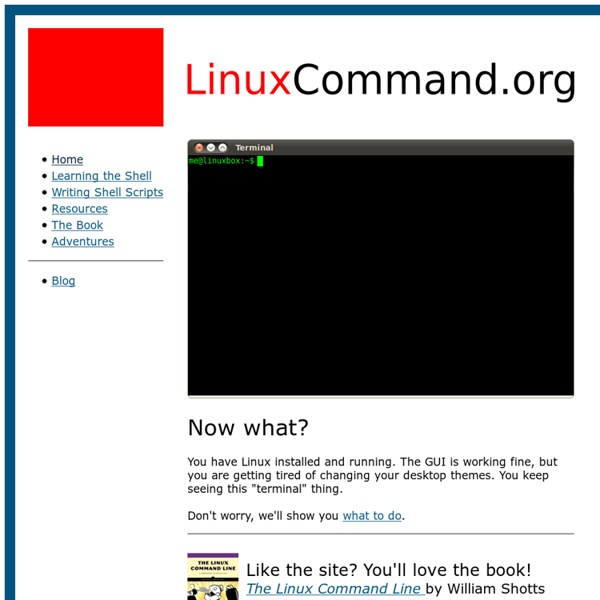



http://linuxcommand.org/index.php
Related: Linux • linux • pbesk18Polysh's homepage Polysh is a tool to aggregate several remote shells into one. It is used to launch an interactive remote shell on many machines at once. It is written in Python and requires Python ≥ 2.4. Here is the transcript of a sample session: Raspberry Connect - Python Packages for the Python programming language To install Raspbian software on a Raspberry Pi Packages are installed using LXterminal. First get an updated package list by entering the following command in to LXterminal if this has not been done today sudo apt-get updateThen install your chosen package with the command sudo apt-get install package name Find out more with the Guide to installing software with the apt-get command Rate a Raspberry Pi software package from this list Let other users know how well packages work on the Raspberry Pi.
50 Most Frequently Used UNIX / Linux Commands (With Examples) This article provides practical examples for 50 most frequently used commands in Linux / UNIX. This is not a comprehensive list by any means, but this should give you a jumpstart on some of the common Linux commands. Bookmark this article for your future reference. 4.3. Using Software from Planet CCRMA at Home The Planet CCRMA at Home software is hosted (stored) on a server at Stanford University. It is separate from the Fedora Linux servers, so yum (the command line utility used by PackageKit and KPackageKit) must be made aware that you wish to use it. After installing the repository, Planet CCRMA at Home software can be installed through yum, PackageKit, or KPackageKit just as easily as any other software. 4.3.1.
15 Examples To Master Linux Command Line History When you are using Linux command line frequently, using the history effectively can be a major productivity boost. In fact, once you have mastered the 15 examples that I’ve provided here, you’ll find using command line more enjoyable and fun. 1. Improving performance This article provides information on basic system diagnostics relating to performance as well as steps that may be taken to reduce resource consumption or to otherwise optimize the system with the end-goal being either perceived or documented improvements to a system's performance. The basics Know your system The best way to tune a system is to target bottlenecks, or subsystems which limit overall speed. The system specifications can help identify them.
Converting videos in Ubuntu using FFMPEG If you are a multimedia junkie and felt it your karma to convert tons of videos and music to popular formats, then FFMPEG is the right tool for you. FFmpeg is a free video converter and so much more. It can be found in the default Ubuntu repository and also comes pre-installed in most other distro's.
Customizing Fedora 25 for Developers I dusted off a 4 years old Lenovo ThinkCentre Edge 71z Tower desktop and Lenovo IdeaPad G400s notebook. They are, respectivelly, a 2nd generation Core i5 SandyBridge 2.5Ghz and Core i3 2.4Ghz, with 8GB of RAM in the Tower and 4GB of RAM in the notebook. For a developer's routine, they are quite good enough. A better CPU wouldn't do a whole lot. I was very happy to see that this old tower has an old Intel graphics card with a DVI port. Fortunatelly I had an old DVI-to-HDMI cable around and I was able to hook it up to my ultrawide LG monitor 21:9 (2560x180) and it properly scaled everything (macOS Sierra had a regression that required a hack to make it work!)
Troubleshooting Using dmesg Command in Unix and Linux by Balakrishnan Mariyappan on October 26, 2010 During system bootup process, kernel gets loaded into the memory and it controls the entire system. When the system boots up, it prints number of messages on the screen that displays information about the hardware devices that the kernel detects during boot process. These messages are available in kernel ring buffer and whenever the new message comes the old message gets overwritten. You could see all those messages after the system bootup using the dmesg command. 1. Musicians' Guide Copyright © 2011 Fedora Project Contributors. The text of and illustrations in this document are licensed by Red Hat under a Creative Commons Attribution–Share Alike 3.0 Unported license ("CC-BY-SA"). An explanation of CC-BY-SA is available at The original authors of this document, and Red Hat, designate the Fedora Project as the "Attribution Party" for purposes of CC-BY-SA. In accordance with CC-BY-SA, if you distribute this document or an adaptation of it, you must provide the URL for the original version. Red Hat, as the licensor of this document, waives the right to enforce, and agrees not to assert, Section 4d of CC-BY-SA to the fullest extent permitted by applicable law.
I'm looking forward to chance to learn how to write shell scripts from: by williamellerbe Sep 24